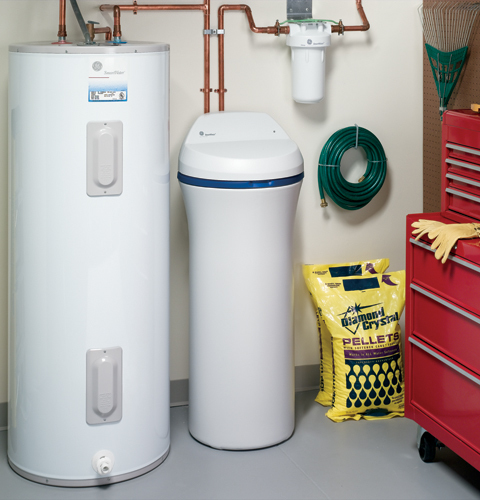The reason behind a water softening system is simple; it removes dissolved rock from a “hard” water supply. Since water dissolves more substances than any other liquid, including even sulfuric acid, it is frequently full of dissolved minerals. The most common of these are calcium & magnesium. These minerals don’t impact your health in a negative way, but they are responsible for a wide range of troublesome problems in your home.
Ever noticed a white buildup on your showerhead? Ever noticed how difficult it is to clean off spots on your shower wall? Do you wonder why your dishes come out of the dishwasher looking cloudy & still dirty? That’s hard water. The biggest problems, however, are the things most people never see: the interior of appliances. Look inside your water heater and check the heating element. You’ll be in for a shock! The Water Quality Association did a scientific study of soft water and found that a typical electric water heater will last TWICE as long if it is fed softened water. There’s lots of great information on this page about the benefits of owning a water softener.
Here’s the point. If you are planning on upgrading any water-using appliance in your home, you need to consider your water quality first. You’ll be saving yourself time and money in costly repairs as well as experience better performance over the long term. In fact, a water softener may be the only appliance that improves your everyday life while also saving you more than the cost in the process.
Can I Install a Water Softener Myself?
This is a question we hear often and it implores other questions:
- Can you trim your grass?
- Can you change an electrical outlet?
- Can you fit a bathroom tap?
- Can you replace your trash removal?
If you can do at least tw0 of the above things, you can probably fit a water softener. I must admit that it is not for everyone. It is imperative that you make sure the company you order from offers live technical support (especially on weekends) & has good installation instructions. US Water Systems offers expert advice from certified water specialists every day of the year AND they have actual how-to videos to follow along with. Having said this, the process isn’t too complicated. There are only four things to connect when you install a water softener:
- Inlet Connection
- Outlet Connection
- Drain Line
- Plug it into an Outlet
There is one caution to an effective water softener installation: You need two eyes, two ears and one mouth! There’s a cause for that. It’s so you can read the guide, watch the video and ask questions. Honestly, the installations with the most difficulties with are when plumbers or water dealers who “know it all” try to install something without reading the manual or looking at the video or asking help from our technical maintenance sector.
We have the greatest results with individuals who are careful, not over-confident and pursue assistance. US Water also has a full variety of accessories, plumbing and guidelines on how to fit any water softener, such as John Guest Fittings, Sharkbite Fittings and Falcon Stainless Flexible Fittings.
Finally, with the arrival of Flexible Stainless Connectors, Shark-Bite Fittings, and Quick-Connect, it really takes no exceptional abilities to install a water softener, and many plumbers are not pleased that they may have to pursue a new occupation path if they are determined on the ancient way of doing things. Can you do it? I can’t say, but thousands of people like you do it every year and save hundreds of dollars each time in the process.
If you are looking to upgrade a bathroom, kitchen, or other water-using appliance, you owe it to yourself to speak with an expert from USWaterSystems.com they may even give you a free water test!

